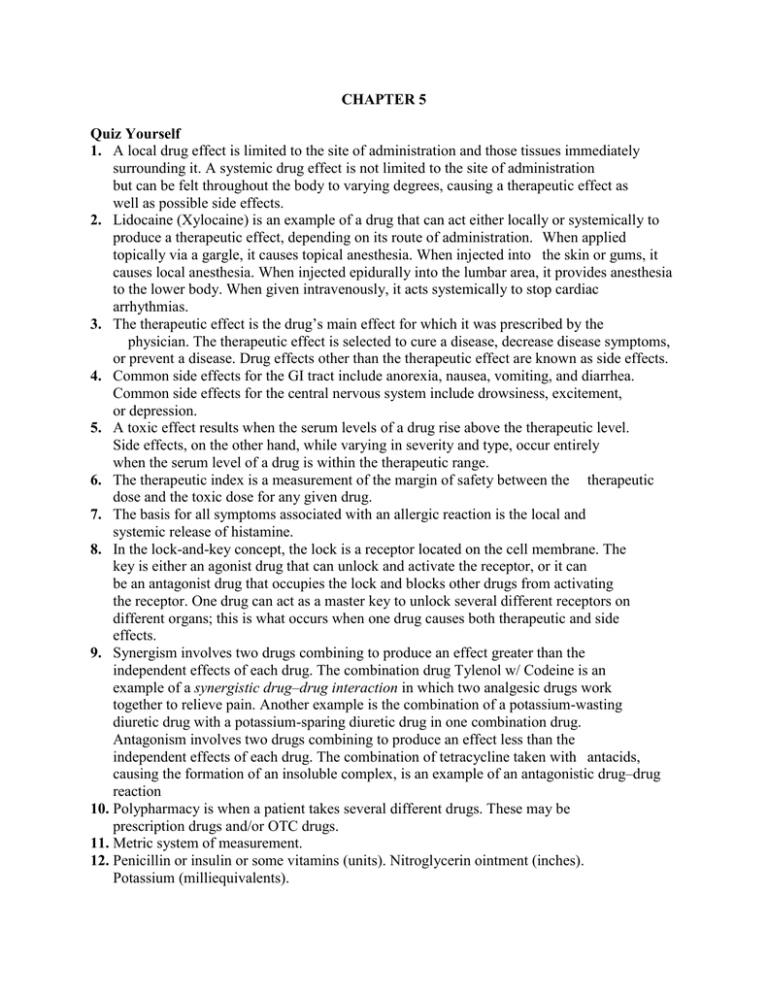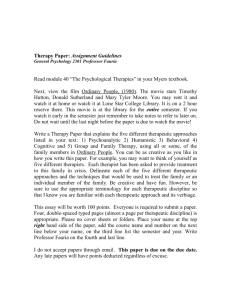CHAPTER 5 Quiz Yourself 1. A local drug effect is limited to the site
advertisement

CHAPTER 5 Quiz Yourself 1. A local drug effect is limited to the site of administration and those tissues immediately surrounding it. A systemic drug effect is not limited to the site of administration but can be felt throughout the body to varying degrees, causing a therapeutic effect as well as possible side effects. 2. Lidocaine (Xylocaine) is an example of a drug that can act either locally or systemically to produce a therapeutic effect, depending on its route of administration. When applied topically via a gargle, it causes topical anesthesia. When injected into the skin or gums, it causes local anesthesia. When injected epidurally into the lumbar area, it provides anesthesia to the lower body. When given intravenously, it acts systemically to stop cardiac arrhythmias. 3. The therapeutic effect is the drug’s main effect for which it was prescribed by the physician. The therapeutic effect is selected to cure a disease, decrease disease symptoms, or prevent a disease. Drug effects other than the therapeutic effect are known as side effects. 4. Common side effects for the GI tract include anorexia, nausea, vomiting, and diarrhea. Common side effects for the central nervous system include drowsiness, excitement, or depression. 5. A toxic effect results when the serum levels of a drug rise above the therapeutic level. Side effects, on the other hand, while varying in severity and type, occur entirely when the serum level of a drug is within the therapeutic range. 6. The therapeutic index is a measurement of the margin of safety between the therapeutic dose and the toxic dose for any given drug. 7. The basis for all symptoms associated with an allergic reaction is the local and systemic release of histamine. 8. In the lock-and-key concept, the lock is a receptor located on the cell membrane. The key is either an agonist drug that can unlock and activate the receptor, or it can be an antagonist drug that occupies the lock and blocks other drugs from activating the receptor. One drug can act as a master key to unlock several different receptors on different organs; this is what occurs when one drug causes both therapeutic and side effects. 9. Synergism involves two drugs combining to produce an effect greater than the independent effects of each drug. The combination drug Tylenol w/ Codeine is an example of a synergistic drug–drug interaction in which two analgesic drugs work together to relieve pain. Another example is the combination of a potassium-wasting diuretic drug with a potassium-sparing diuretic drug in one combination drug. Antagonism involves two drugs combining to produce an effect less than the independent effects of each drug. The combination of tetracycline taken with antacids, causing the formation of an insoluble complex, is an example of an antagonistic drug–drug reaction 10. Polypharmacy is when a patient takes several different drugs. These may be prescription drugs and/or OTC drugs. 11. Metric system of measurement. 12. Penicillin or insulin or some vitamins (units). Nitroglycerin ointment (inches). Potassium (milliequivalents). 13. True. 14. a. a.c. before meals b. b.i.d. twice a day c. g gram d. h.s. hours of sleep, at bedtime e. mcg microgram f. mg milligram g. mL milliliter h. mEq. milliequivalent i. p.r.n. as needed j. t.i.d. three times a day 15. A pediatric drug dose is calculated based on the total body weight of the patient, not the age. Pediatric drug doses are expressed as mg/kg/day (milligrams of drug per kilogram of body weight per 24-hour period). 16. Chemotherapy drug doses are calculated based on the patient’s total body surface area. Chemotherapy drug doses are expressed as mg/m2 (milligrams of drug per meter squared of body surface area). Clinical Applications Questions 1 Do not take with nitrates (drug–drug interaction). May cause drowsiness (other warning to prevent side effects). Do not drink (drug–alcohol interaction). Take with food or milk (other warning to prevent side effects). Finish all of this medication unless otherwise directed by the prescriber (other warning). Take with plenty of water (other warning to prevent side effects). 2. a. Yes. b. Liver and kidneys. c. Drug Name Accupril Actos aspirin Catapres-TTS-1 Lasix Glucotrol XL Humulin N K-Dur Lanoxin lorazepam Metamucil Prozac Zantac Risperdal Serevent Used to Treat hypertension diabetes mellitus pain hypertension hypertension and congestive heart failure diabetes mellitus diabetes mellitus potassium supplement drug congestive heart failure anxiety laxative drug for constipation anxiety and depression heartburn and peptic ulcer psychosis bronchodilator drug for lung disease Synthroid Celebrex Zaroxolyn Ambien Levaquin thyroid hormone replacement drug arthritis pain diuretic drug for congestive heart failure insomnia antibiotic drug for respiratory infection d. Yes, this patient is at risk for a drug–drug interaction.




